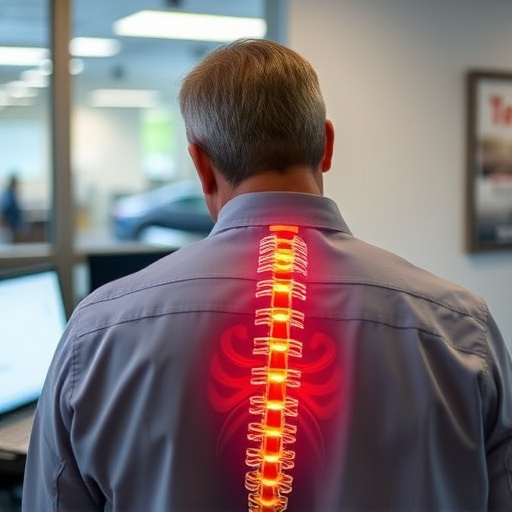Manual therapy is a non-invasive, hands-on approach for restoring spine alignment and addressing chronic spinal conditions, often covered by Personal Injury Protection (PIP) insurance policies within a 14-day rule timeframe. This method focuses on correcting misalignments, reducing pain, and improving physical function, with early intervention enhancing healing and preventing long-term complications. Choosing a qualified practitioner with specific training in spinal manipulation techniques is crucial for safe and effective treatment, leveraging PIP insurance to cover sessions and promote affordable care for spine alignment issues.
“Discover the transformative power of manual therapy in restoring proper spine alignment. This comprehensive guide explores effective techniques, the role of PIP insurance in covering these treatments, and the fascinating 14-Day Rule. From understanding the science behind manual therapy to choosing the right practitioner, we demystify this ancient practice. Learn how it benefits your overall well-being and enhances mobility, offering a natural alternative for pain relief and improved posture.”
- Understanding Manual Therapy for Spine Alignment
- The Role of PIP Insurance in Coverage for Manual Therapy
- What is the 14-Day Rule and How Does it Apply?
- Benefits of Manual Therapy for Restoring Proper Spine Alignment
- Types of Manual Therapy Techniques Used
- Choosing a Qualified Practitioner: Tips and Considerations
Understanding Manual Therapy for Spine Alignment

Manual therapy is a hands-on approach to restoring proper spine alignment and mobility. This technique involves skilled therapists who use their knowledgeable hands to perform various manipulation and movement strategies. These methods aim to correct spinal misalignments, reduce pain, and improve overall physical function. Manual therapy can be an effective alternative or adjunct to other treatments like medication or surgery.
Understanding the benefits of manual therapy is crucial, especially when considering PIP (Permanent Impairment) insurance claims and the 14-day rule. Many patients find relief from chronic spinal conditions through this method. By addressing underlying issues, manual therapists help individuals regain control over their bodies, promoting long-term wellness. This natural approach to healthcare is gaining recognition for its ability to provide lasting results without invasive procedures or medications.
The Role of PIP Insurance in Coverage for Manual Therapy

Many patients seeking manual therapy for spine alignment issues are often curious about their insurance coverage. In the United States, Personal Injury Protection (PIP) insurance plays a significant role in funding these treatments, especially when it comes to back and neck pain relief through manual therapy techniques. The 14-day rule is a crucial aspect of PIP insurance policies, dictating that medical providers must treat patients within a specific timeframe after an accident or injury. This rule ensures prompt care, which can be critical for managing acute pain and preventing long-term issues related to improper spine alignment.
When a patient visits a licensed therapist for manual therapy sessions, the PIP insurance policy may cover these treatments if they are deemed medically necessary. The 14-day rule provides a framework for healthcare providers to deliver care efficiently, making it easier for patients to access affordable and timely treatments for their spinal misalignments. Understanding coverage details and eligibility criteria is essential for both patients and therapists to ensure smooth treatment processes and financial peace of mind.
What is the 14-Day Rule and How Does it Apply?

The 14-Day Rule, often referenced in PIP (Personal Injury Protection) insurance policies, is a crucial concept for individuals undergoing manual therapy for spine alignment issues. This rule dictates that treatment or care must commence within a specified period—typically 14 days—after an accident or injury that resulted in spinal damage. The primary goal of this regulation is to ensure prompt intervention and maximize the benefits of manual therapy.
When a patient’s spinal alignment is affected due to an insured event, availing treatments like chiropractic adjustments or physical therapy within this 14-day window can significantly enhance healing outcomes. It allows healthcare providers to address the issue while the body’s natural healing mechanisms are still active and responsive. PIP insurance encourages early intervention by setting this timeframe, ensuring that patients receive necessary care promptly and potentially preventing long-term complications related to spinal misalignment.
Benefits of Manual Therapy for Restoring Proper Spine Alignment

Manual therapy, often a key component in chiropractic care, offers numerous benefits for restoring proper spine alignment. This non-invasive approach involves skilled hands-on manipulation of the spine and other joints to correct misalignments, also known as subluxations. By addressing these issues, manual therapy can alleviate pain, improve mobility, and enhance overall spinal health. It promotes self-healing by stimulating the body’s natural restorative mechanisms, reducing inflammation, and increasing blood flow to affected areas.
For individuals covered by PIP (Personal Injury Protection) insurance, understanding the 14-day rule is essential. This rule stipulates that certain treatments, including manual therapy, must be initiated within a specified time frame after an injury. Taking advantage of these benefits can lead to better long-term outcomes and cost savings, as it helps prevent chronic pain and reduces the need for more intensive or prolonged treatments.
Types of Manual Therapy Techniques Used

Manual therapy offers a range of techniques tailored to address specific spine alignment issues, often covered under PIP insurance policies following the 14-day rule. One common approach is chiropractic manipulation, where therapists use their hands or a small instrument to apply controlled force to joints, improving mobility and reducing pain. This method is effective for treating conditions like herniated discs, spinal stenosis, and misaligned vertebrae.
Another popular technique is osteopathic manipulation, focusing on the connection between the body’s structure and its function. Therapists use various hands-on methods, including deep tissue massage, joint mobilization, and soft tissue release, to alleviate muscle tension and restore balance in the spine. These techniques are particularly beneficial for conditions such as chronic back pain, poor posture, and sports injuries.
Choosing a Qualified Practitioner: Tips and Considerations

When considering manual therapy for spine alignment, choosing a qualified practitioner is paramount to ensuring safe and effective treatment. Look for certified professionals with relevant training in manual therapy techniques specific to spinal manipulation. Verify their credentials, experience, and any specialized certifications. Reputable practitioners often possess advanced degrees or diplomas in chiropractic, osteopathy, or physical therapy.
In many regions, insurance coverage plays a significant role. Check if your PIP (Personal Injury Protection) insurance covers manual therapy sessions within the 14-day rule, which allows for specific treatment types following an injury. Additionally, ask about pricing and payment plans to ensure financial transparency. Reputable practitioners provide clear information about their services, fees, and expected outcomes, fostering trust and ensuring you make an informed decision.














